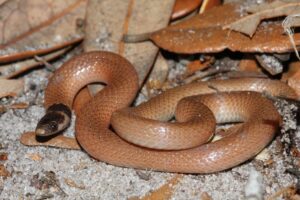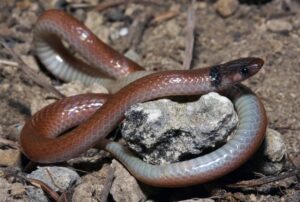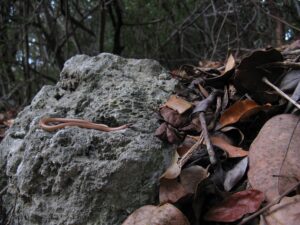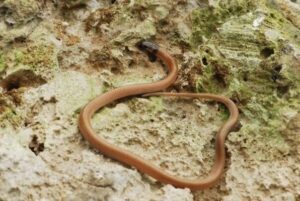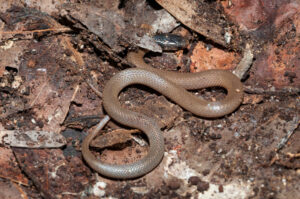The rim rock crowned snake is a solitary, nocturnal species with limited distribution. It belongs to the colubrid family and is commonly known as blackhead snake, centipede snake, or Miami black-headed snake. First described in 1966, this species gets its name after the Miami Rim Rock land arrangements. Their genus name ‘Tantilla’ derives from the Latin word tantillus, meaning “so small”. And the specific epithet ‘oolitica’ refers to Florida’s oolitic limestone area, their natural habitat.
Scientific Classifications
- Suborder:Serpentes
- Family:Colubridae
- Genus:Tantilla
- Species:T.oolitica
Conservation Status
Subspecies
Because of certain similarities, some scientists consider the rim rock crowned snake a subspecies of the southeastern crowned snake (Tantilla coronata). But this is yet to be confirmed due to a lack of data.
Description
Size
The length of rim rock crowned snakes reaches 7-9 inches (18-23 cm), with the highest recorded length of 11.5 inches (29 cm).
Color and Appearance:
These snakes have small, slender, pinkish-tan-colored upper bodies, and the underside of their bodies is usually pale grey or white, usually with black spots. Their heads and necks range from dark brown to black, with a pale cream to tan snout and small eyes with round pupils. Behind both eyes, there are small light blotches. Complete to partial banding of light color on the back of the head is seen in specimens from the Florida Keys. This banding is absent in all the other specimens living on the mainland.
They have 15 smooth dorsal scale rows at the midbody. Juveniles and adults are almost indistinguishable in color.
Are they Dangerous
It is a mostly non-venomous species with mild venom incapable of hurting humans or pets. They deliver the venom through slightly enlarged grooved teeth to subdue prey. Rim rock crowned snakes are not aggressive and do not bite even out of defense.
Rim Rock Crowned Snake At a Glance
Distribution
Its range is limited to the Dade and Monroe counties of Florida and the Florida Keys, and the Eastern Rock Rim of Miami. They also occur in many Miami localities like Leisure City, Perrine, Coconut Grove, North Miami, Cutler, Kendall, Brownsville, Coral Gables, and Cutler Ridge.
Habitat
These snakes prefer to inhabit oolitic limestone crevices, rotten logs and debris, rocky areas, pine flatwoods, areas with sandy soils, and tropical hardwood hammocks that are present around fresh water. They tend to stay away from populated urban and suburban areas.
Lifespan
Their average lifespan is about five years.
Predators
Natural enemies of the rim rock crowned snake include birds, cats, larger snakes like the coral snake, scorpions like the slender brown scorpion, and probably any carnivorous animal large enough to hunt them. However, they stay hidden most of the time, which is their best defense.
To defend themselves from threat, they secrete musk from the two glands located in their tail, and sometimes they also may squirm.
Diet
More information about their diet is yet to be discovered since they are difficult to observe due to their secretive lifestyle. But similar to other species in their genus, these snakes probably also eat small invertebrates like beetle larvae, scorpions, snails, and spiders.
One time a hiker found a dead rim rock crowned snake. After scanning the specimen, scientists said it died choking on a centipede. So, one can assume that centipedes are also a part of their diet.
Reproduction
The information about their reproduction is unknown. Females lay about 1-4 eggs. Juveniles become sexually mature probably when they are two years old.
Similar Species
Florida Crowned Snake
The Florida crowned snake appears almost identical to the rim rock crowned snake. However, this species may sometimes have a pale band separating the head and neck areas.
FAQs
Ans: One of the biggest reasons is habitat fragmentation, as most of their habitats mixed with agricultural lands and residential areas over time. Also, their freshwater sources get salinated due to the rising sea level.
Ans: This is a rare species with a recorded population of 26 individuals. There may be more in the wild, but they are yet to be discovered.
Source
fws.gov, fbcdn.net, floridamuseum.ufl.edu, inaturalist.org

